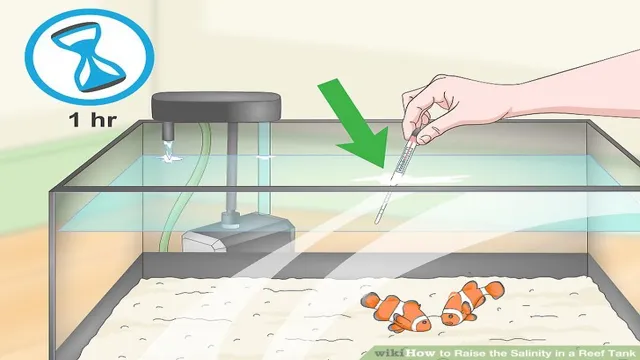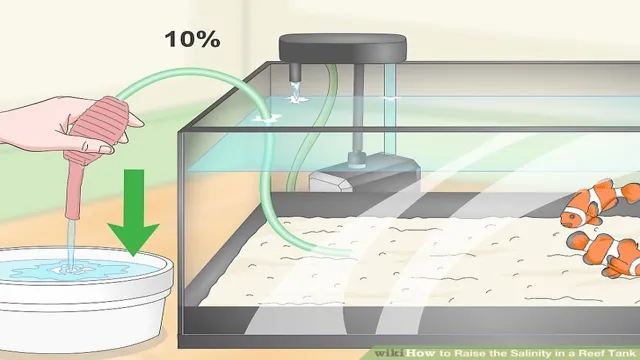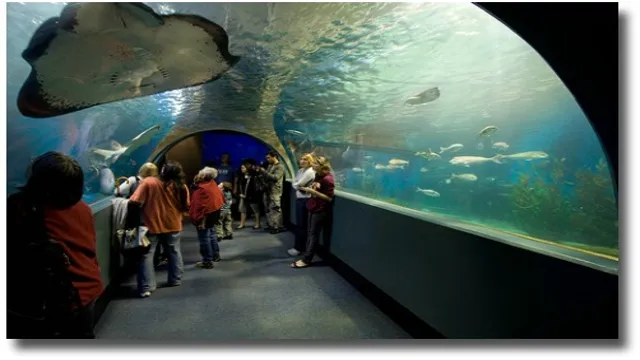Have you ever wondered how to adjust salinity in your aquarium to provide the best living conditions for your aquatic pets? Maintaining a proper salinity level is crucial to the health and well-being of your aquarium inhabitants, and requires attention and effort on your part as a conscientious owner. Salinity refers to the amount of dissolved salts in the water, and directly influences the osmotic pressure and behavior of the animals in the tank. Inadequate salinity can lead to stress, disease, and even death for your aquatic pets, while excessive salinity can be equally harmful.
So, how can you measure and adjust the salinity in your aquarium? There are several methods, including the use of refractometers, hydrometers, or conductivity meters, depending on your preference and the specific needs of your tank. Once you have determined the current salinity level, you can make appropriate adjustments through the addition or removal of saltwater or freshwater, as needed. But it’s important to remember that salinity is just one factor in maintaining a healthy aquarium environment.
Consistent and diligent attention to water quality, temperature, filtration, and feeding are also essential components to preserving the vitality and longevity of your aquatic pets. In short, adjusting salinity in your aquarium is a critical aspect of responsible pet ownership, and requires careful consideration and attention to detail. By keeping a watchful eye on the salinity level, and taking action when necessary, you can help create a safe, comfortable, and thriving environment for your aquatic friends.
Understanding Salinity Levels
Maintaining the right salinity levels is vital for the health of your aquarium inhabitants. If you are wondering how to adjust salinity in aquariums, you first need to understand the salinity level that is ideal for your specific aquatic species. Different fish and other aquatic creatures have different salinity preferences, so it’s important to do your research and understand the needs of your aquarium inhabitants.
Once you have identified the ideal salinity for your aquarium, you can adjust the levels using specialized tools and equipment. For example, a hydrometer is a useful tool that can help you measure the salt concentration in your aquarium water. Remember to make gradual adjustments to your salinity levels, as sudden changes can be harmful to your fish and other aquatic creatures.
With the right information and tools, adjusting and maintaining salinity levels in your aquarium can be done with ease, ensuring the good health and longevity of your aquatic friends.
What is salinity in aquariums?
Salinity levels in aquariums are an essential aspect of maintaining a healthy and thriving aquatic ecosystem. Simply put, salinity refers to the concentration of salt in the water. Maintaining the appropriate salinity level is critical as it affects the health, growth, and reproduction of fish and other organisms inhabiting the aquarium.
The ideal salinity level varies depending on the type of aquarium. For instance, a saltwater reef aquarium requires a higher salinity level than a freshwater aquarium. It is crucial to note that salinity levels can fluctuate due to factors such as temperature, water evaporation, and water changes.
Therefore, regular monitoring and adjustments of salinity levels are crucial to maintaining the stability of the aquarium’s environment. Overall, understanding and maintaining the appropriate salinity levels are critical to promoting the health and longevity of aquatic life in aquariums.

Why is salinity important for aquariums?
Salinity is a crucial factor to consider when setting up an aquarium. It refers to the level of salt content in the water and is measured in parts per thousand (ppt). Different types of aquatic species require different levels of salinity, which is why it is essential to understand the salinity requirements of the fish and plants you plan to keep in your aquarium.
For instance, marine fish require a higher salinity level ranging from 30 to 40 ppt, while freshwater fish thrive in a salinity level of 0 to 5 ppt. Maintaining the correct salinity level in your aquarium is essential to keep your aquatic pets healthy and prevent the growth of harmful bacteria in the water. It is recommended to monitor the salinity levels of your aquarium regularly and perform proper water changes and filter maintenance to keep the salt content at optimal levels.
In summary, the salinity level in an aquarium is an important factor to ensure the health of your aquatic pets.
What are the ideal salinity levels for different types of aquariums?
Salinity levels can play a crucial role in maintaining the health and well-being of your aquarium’s inhabitants. Understanding the ideal salinity levels can prove difficult, especially with the variety of aquarium types available. For freshwater aquariums, salinity is not a concern, and having a low salinity level is preferred.
However, for saltwater aquariums, salinity levels are essential and should be maintained at around 023 – 025 specific gravity.
Certain marine species, such as fish and invertebrates, require these optimal levels to thrive. Reef aquariums, on the other hand, require a more precise salinity level of 025 –
026 specific gravity. Any deviation from these levels can affect coral growth and could negatively impact the aquarium’s overall health. It is crucial to monitor salinity levels regularly using a hydrometer or refractometer to ensure the best environment for your aquatic pets. (See Also: How to Care for Seahorses in an Aquarium: A Comprehensive Guide for Beginners and Experts Alike)
Testing Salinity Levels
Maintaining the proper salinity levels in an aquarium is essential for the health and well-being of its inhabitants. Salinity measures the amount of salt in the water and affects the osmotic balance of the creatures living in the aquarium. To adjust the salinity, you can add or remove saltwater.
If the salinity is too high, you can dilute it with freshwater. On the other hand, if salinity levels are too low, you can add salt mixture to the water until the desired level is reached. It is essential to use a hydrometer or a refractometer to measure salinity levels accurately.
It is also important to remember that sudden changes in salinity can cause stress to the aquarium’s inhabitants, so it’s best to make changes gradually over time. With proper attention paid to these salinity levels and adjustments made as necessary, your aquarium will be a thriving and healthy environment for your aquatic creatures.
How to test salinity levels in aquariums
If you are an aquarium enthusiast, you probably know the importance of maintaining the proper salinity levels in your aquarium. Salinity refers to the amount of dissolved salts in the water and is measured in parts per thousand (ppt). Testing salinity levels is crucial because different species of fish have varying tolerance levels to salinity.
Fortunately, testing salinity levels in your aquarium is a simple and straightforward process. You can use a hydrometer or a refractometer to test the salinity levels accurately. A hydrometer operates similarly to a thermometer, as it measures the specific gravity of the water, which is directly related to the salinity level.
A refractometer uses light refraction to measure the salinity level of the water. Both methods are relatively easy to use, but a refractometer provides more accurate results. It’s crucial to test the salinity levels regularly, especially if you have a saltwater aquarium, to ensure your fish thrive in the ideal aquatic environment.
What tools and equipment are necessary for testing salinity?
When it comes to testing salinity levels, there are several tools and equipment necessary for accurate results. One of the essential tools is a refractometer, which measures the index of refraction of a liquid. This device is used to test the salinity in both freshwater and saltwater aquariums.
Another necessary tool is a hydrometer, which measures the density of the water. This device can test the salt concentration in the water and determine if it is at the right level. A conductivity meter is also critical when testing salinity.
It measures the electrical conductivity of the water, which is directly related to the amount of salt in the water. Other equipment includes a thermometer, a pH meter, and calibration solutions for accurate readings. It is essential to ensure all equipment is calibrated correctly, or the results may be inaccurate.
By using the right tools and equipment, aquarists can maintain proper salinity levels and keep their aquatic organisms healthy and thriving.
How often should you test salinity levels?
Salinity levels in aquariums are essential to the health and well-being of your aquatic pets. Testing salinity levels is crucial to ensure that the water is not too salty or not salty enough for the specific species you possess. Generally, salinity levels should be tested regularly every week to keep track of any fluctuations, with more frequent testing during times of change such as after a water change.
However, it’s essential to test salinity levels before adding new fish or invertebrates, or if you notice any health issues in your current aquatic pets. Ultimately, maintaining proper salinity levels helps to promote healthy living conditions that contribute to the overall longevity of your aquarium inhabitants. Keep in mind, it’s best to use a reliable testing kit and follow the specific instructions for accurate and consistent results.
Adjusting Salinity Levels
If you’re keeping fish, live corals, or invertebrates in your aquarium, it’s important to keep a close eye on the salinity levels. Fluctuations in salinity can cause stress or even death for your aquatic pets. Luckily, adjusting salinity levels is something that can be done easily with a few basic steps.
The first thing you’ll need to do is test the water salinity with a reliable hydrometer or refractometer. If the salinity is too low, you can increase it by adding marine salt mix to the tank. Be sure to follow the instructions on the salt mix carefully and allow time for it to fully dissolve before testing the salinity again.
If the salinity is too high, you can dilute the tank water by adding fresh water in small increments over a period of time. Remember, it’s important to make any adjustments to salinity gradually to avoid shocking the aquatic inhabitants. By monitoring salinity levels regularly and taking quick action when necessary, you can maintain a healthy and thriving aquarium. (See Also: How to Prepare Eggshells for Aquarium: A Step-by-Step Guide for Nutrient-Rich Water)
How to raise or lower salinity in aquariums
If you’re an aquarium enthusiast, you know how important it is to maintain the right salinity levels in your tank. Whether you’re dealing with a freshwater or saltwater aquarium, adjusting salinity levels is crucial in keeping your plants and fish healthy. Raising or lowering salinity in your aquarium can be done in a few easy steps.
To raise the salinity levels, you can add marine salt mix to your tank. However, you need to be careful not to add too much as this can stress and harm the animals and plants in your tank. To lower the salinity levels, removing water and replacing it with freshwater is the most effective method.
It’s important to keep monitoring the salinity levels of your aquarium to ensure they are always within the optimal range. Remember to take things slow and steady, to avoid disrupting the equilibrium of the ecosystem in your tank.
What products or methods to use to adjust salinity?
When it comes to adjusting salinity levels, there are various products and methods you can use. One common product is aquarium salt, which is specifically designed for use in freshwater aquariums. This type of salt contains all the necessary elements to maintain proper salinity levels without harming your fish or other aquatic life.
You could also add small amounts of marine salt mix to your freshwater aquarium to slowly increase salinity levels over time. Another option is to add reverse osmosis (RO) water to your aquarium to reduce the salinity levels. This is particularly useful if you have accidentally added too much salt and need to adjust the levels quickly.
Regardless of the method you choose, it’s important to monitor the salinity levels on a regular basis to ensure your aquatic life remains healthy and happy.
Maintaining Salinity Levels
Maintaining the proper salinity levels in your aquarium is essential for the health and well-being of your aquatic pets. The ideal salinity levels for most aquariums fall between 020 to
025, but you may need to adjust them depending on the type of fish and plants that you have. If the salinity is too high or too low, it can lead to stress, illness, or even death. To adjust the salinity levels, you can add or remove saltwater from your aquarium with a hydrometer or refractometer.
Make sure to add small amounts of saltwater and test the salinity level frequently until you reach the desired range. Conversely, if you need to lower the salinity, you can either add freshwater or use a reverse osmosis system to reduce the salt content. Keep in mind that abrupt changes in salinity levels can be detrimental to your aquarium’s inhabitants.
Therefore, make any adjustments gradually over a period of several days. With proper maintenance and monitoring, your aquarium can thrive, keeping your aquatic pets healthy and happy.
How to maintain consistent salinity in aquariums
Maintaining Salinity Levels in Aquariums Maintaining consistent salinity levels is crucial for the health and well-being of your aquarium’s inhabitants. Fluctuations in salinity can stress your aquatic pets, leading to potential health issues. So, how can you ensure that your aquarium’s salinity levels stay consistent? Firstly, invest in a reliable salinity meter to monitor the levels accurately.
Secondly, use high-quality salt mix to create a balanced solution in your aquarium. Thirdly, conduct regular water changes to maintain the proper salinity levels. Lastly, be cautious when introducing new flora and fauna, as sudden changes in salinity can disrupt the balance of your aquarium’s ecosystem.
By following these steps, you can ensure that your aquarium’s salinity levels remain consistent, providing a healthy environment for your aquatic pets to thrive in.
What other factors affect salinity levels in aquariums?
When it comes to maintaining salinity levels in an aquarium, there are several other factors to consider beyond just adding salt. One important factor is water evaporation, which can increase the salinity levels if not compensated for by adding freshwater. Another factor is the quality of the salt mix being used, as different brands and types can vary in their composition and affect salinity levels. (See Also: How to Add Live Rock to a Saltwater Aquarium: A Beginner’s Guide to Getting Started with Rock Aquascaping)
It is also important to monitor the feeding habits of any fish or invertebrates in the aquarium, as uneaten food can decompose and release nutrients that can alter salinity levels. Finally, regular water changes and maintenance can help ensure consistent salinity levels and keep the aquarium healthy for its inhabitants. By taking these factors into account and staying vigilant in maintaining salinity levels, aquarists can provide a thriving environment for their aquatic pets.
Final Tips for Salinity Maintenance
Maintaining salinity levels in your aquarium can be challenging but is essential for the health of your fish and other underwater creatures. One tip for maintaining salinity levels is to test the water frequently. This will help you identify any changes in salinity and allow you to adjust the levels if necessary.
Another tip is to use high-quality salt mixtures that are specifically designed for aquariums to ensure that the salinity levels are stable and consistent. Additionally, avoid overfeeding your fish as excess food can produce waste, which can lead to a decline in water quality and alter the salinity levels. Overall, by staying vigilant and taking the necessary steps to ensure the proper maintenance of salinity levels, you can support the health and vitality of your aquarium ecosystem.
Conclusion
In the ever-changing world of aquariums, maintaining the perfect salinity can be a tricky task. However, with a little know-how and a lot of patience, adjusting salinity in your aquarium is completely doable. Whether you’re raising tropical fish or just want a beautiful coral display, keeping salinity levels in check is essential for a healthy environment.
So don’t let high or low salinity levels throw your aquarium equilibrium off balance- take the time to tweak those levels and revel in the beauty of a perfectly adjusted tank. Your fish (and your Instagram followers) will thank you for it!”
FAQs
Why is it important to adjust salinity in aquariums?
Salinity levels affect the health and wellbeing of fish and other aquatic creatures, so ensuring the correct levels is vital for their survival.
What tools can be used to test the salinity levels in an aquarium?
There are a variety of tools available, including refractometers, hydrometers, and conductivity meters.
What is the ideal salinity range for a saltwater aquarium?
The ideal range is usually between 1.020 and 1.026, but it may depend on the specific needs of the creatures in the aquarium.
What are some common causes of fluctuations in salinity levels?
Adding or removing water from the aquarium, evaporation, and various environmental factors can all contribute to fluctuations in salinity levels.
What should a fish owner do if they notice their aquarium’s salinity levels are too high or too low?
They should slowly adjust the salinity levels by adding freshwater or saltwater as needed to bring it to the appropriate range.
How often should salinity levels be checked in an aquarium?
This may vary depending on the aquarium environment, but it’s generally recommended to check salinity levels at least once a week.
Can high salinity levels harm fish and other aquatic creatures?
Yes, high salinity levels can cause dehydration and stress, which can lead to illness or even death in severe cases.






